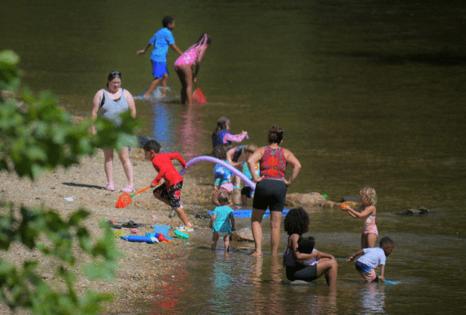Maryland state parks adjust as pandemic popularity endures
Published in News & Features
BALTIMORE — Maryland state parks are in their busy season, with yearly attendance still millions more than before the COVID-19 pandemic.
“We were discovered in and after the pandemic, and we stayed discovered,” Tim Hamilton, the business and marketing manager for the Maryland Park Service, said in an interview with The Baltimore Sun. “Our staff is running a small city.”
The state’s more than 60 state parks — including beaches, forests, mountains, and historical sites – saw 18.5 million visitors in 2024, according to data from the Maryland Department of Natural Resources. That’s down 14% from the pandemic high of 21.6 million visitors in 2020, but 24% above the 14.9 million visitors in 2019.
The influx has led the Maryland Park Service to make changes, including a new reservation system at five parks and added responsibilities for park rangers. Multiple park advocates told The Sun that the system’s expanded budget and staffing have not kept pace with the increase in park visitors.
“We have a incredible state park system that is routinely underfunded,” Dave Ferraro, the executive director of the Friends of Patapsco Valley State Park, said.
The most visited state parks in both 2024 and 2023 were Seneca Creek in Montgomery County; Patapsco Valley in Baltimore, Carroll, Howard, and Anne Arundel counties; and Assateague in Worcester County. These three parks each saw more than 1.9 million visitors in 2024, according to DNR data.
Visitors said parks near population centers — like Seneca Creek and Patapsco Valley — are an accessible escape from their busy lives.
“There’s a lot that goes on in the world, and state parks bring peace,” said Mia Taylor, a 20-year-old Morgan State University student and Anne Arundel County resident who visits Seneca Creek State Park weekly.
With a $3 billion state budget deficit closed for the current fiscal year and a substantial structural deficit remaining, “broader resource limitations,” have forced adjustments to the state parks system, according to an email response from DNR to a question about the impact of the state budget. The department did not elaborate beyond saying that the park service has assigned staff to support “essential operations.”
The state parks system hired seasonal employees ahead of the state’s hiring pause, according to the email. The pause, announced in late June by Gov. Wes Moore, does not apply to essential positions, including in health care and law enforcement.
The operating budget for the Maryland Park Service is $81.2 million for fiscal 2026, which began this month. In fiscal 2019, before COVID-19 shutdowns contributed to a surge in attendance, its budget was $53 million, or about $67 million in 2025 dollars. That equates to a 21% increase, less than the 24% jump in visitors over the same period.
Coming out of the pandemic, the state government passed the Great Maryland Outdoors Act in 2022, aiming to mitigate staffing shortages in the wake of the visitor surge. The act promised 90 new full-time park service positions on top of the about 260 positions allocated for the park service during the COVID attendance surge.
Chuck Hecker, the president of the Friends of the Maryland State Parks and a former park ranger, said that the promises made by the law have not been realized, as, without enough permanent rangers in the park service, many park rangers remain overwhelmed by their responsibilities.
“We have great rangers in the state park,” Hecker said. “But some of them are doing jobs for three people.”
Bonnie Bell, a volunteer park ranger at Seneca Creek and the treasurer for the park’s “friends of,” volunteer organization, said she has seen the impact of a constricted budget. Some activities, Bell said, have been cancelled or adjusted. The Friends of Seneca Creek and Patuxent State Parks have also paid for some items to help the park deal with unexpected costs, Bell said.
Hamilton, the park service business and marketing manager, said that park service positions predating the Great Maryland Outdoors Act are filled, while some positions, typically in planning positions, called for by the legislation are vacant but are going through the approval process.
A 2024 report on the status of the Great Maryland Outdoors Act found that the staff-to-visitor ratio in individual state parks ranges from 5,800 visitors per one park staff member to nearly 180,000 visitors per employee. From 2003 to 2022, when the Great Maryland Outdoors Act became law, the number of permanent positions in the state parks decreased by 20% while visitorship increased by 73%, according to the report conducted by the state Department of Legislative Services.
One way parks are adjusting to high attendance is a reservation system during summer months for often-crowded parks.
Sandy Point, Greenbrier, North Point, Newtowne Neck and Point Lookout state parks each adopted a parking reservation day-pass system this summer. Required only on weekends and holidays through Labor Day, the system seeks to prevent over capacity closures and reduce the time employees spend handling crowds at entrances and parking lots. In 2024, there were 166 capacity closures in the state park system.
According to DNR, since the registration system began, long lines of cars at the swimming-centered Sandy Point and Greenbrier state parks have disappeared. Greenbrier has been selling out of reservations, Hamilton said, one to three days ahead of time, which he says shows that people are aware of the new system.
The reservation system has allowed employees who would otherwise be directing traffic to perform other duties and has limited the use of police to handle crowds, Hamilton said.
According to DNR, there are no plans to implement the reservation system in any additional park parks, although the parks service is continuing to monitor visitor trends.
----------------
©2025 The Baltimore Sun. Visit at baltimoresun.com. Distributed by Tribune Content Agency, LLC.







Comments